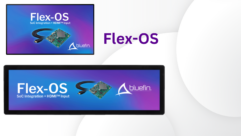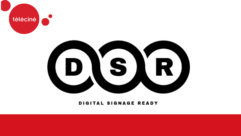
How Digital Signage Can Help in a Tough Economy
Jan 27, 2009 12:00 PM,
By John W. DeWitt

As vacations morph into “staycations” for many Americans, movie theater concessions provide an opportune venue for targeting consumers via electronic menu boards, such as this one powered by Omnivex digital signage software.
Digital signage appears to be substantially insulated from the general cutbacks in spending for technology and advertising. Austin, Texas-based DisplaySearch just released its 2009 forecasts, which predict robust 44 percent growth in unit volume for LCD and plasma screens used for digital signage and large-format commercial display applications.
Indeed, because it’s such an effective visual communications tool, digital signage is an ideal technology for challenging economic times, argues Jeff Collard, president of signage software maker Omnivex.
“If it’s done right, digital signage drives cost out, creates efficiencies, and improves the capabilities of the business,” Collard explains. “In a tough economy, you have to change the way you do business, you have to change the culture of an organization, and that’s a communications challenge. Digital signage … gives people the information they need to make decisions. At retail, it’s a buying decision. On the manufacturing or distribution center floor, it might be staff deployment tied to work-in-process. Regardless of the application, digital signage is about how you strategically use information and in a tough economy, I think that’s key.”
Spurring this growth is a combination of lower unit costs for signage hardware and the proven impact of targeted signage applications in retail, mass transit, and quick-service restaurants, according to DisplaySearch.
“Public display installations are long-term infrastructure projects, and the implementation decisions were made long ago. Current projects will continue to move forward with implementation in the near term, but at a marginally slower pace,” noted Chris Connery, vice president of PC and large format commercial displays at DisplaySearch, who was interviewed by Digital Signage Update earlier this month (read the story). “In particular, deployments of commercial flatpanel products across the globe in mass transit and quick-service restaurant (QSR) markets continue on course for 2009 and 2010.”
In announcing its forecast, DisplaySearch noted that many advertisers have cut their ad spending and are turning to signage applications as a means to a new core audience: business-to-business buyers. Business professionals are flocking to mass transit, especially in major metropolitan areas. Therefore, DisplaySearch says, digital displays on rail platforms and other transportation hubs allow advertisers to focus on business professionals without having to rely on mass-media to reach captive audiences.
How Digital Signage Can Help in a Tough Economy
Jan 27, 2009 12:00 PM,
By John W. DeWitt
Other retail growth areas, DisplaySearch reports, include fast-food restaurants and movie theaters that are deploying electronic menu boards. Cinemas provide a good venue to target buyers as consumers cancel vacation trips and see movies during “staycations.” Electronic displays, linked to point-of-sale (POS) information, allow cinemas to promote in-stock concession stand products as well sell space to outside advertisers.
Such POS-driven applications exemplify where growth opportunities lie for “real” signage that is “not some pre-canned PowerPoint slide,” Collard says. “Digital signage products that are built around mining information and used for decision-making will do well in this economy.”
Outside of retail, Collard foresees substantial growth for signage in applications for corporate communications.
“The great thing about corporations is that they have key performance indicators that they can measure and feed back to people to help motivate them or help them make decisions,” he explains, adding that Omnivex “eats our own dog food” with digital signs deployed in every department. “The sales reps see the sales numbers, for example, and salespeople are competitive so it makes it fun and compelling.”
But, Collard continues, the benefit of this strategic use of visual information “applies to any business.” For instance, “in a call center, you’re measuring call and resolution times, but managers don’t have to sit at their desks. If they can look at the wall, know what’s going on in that area, that’s a powerful tool and employees can’t hide from information.”
The challenging economy will impact the digital signage industry, Collard thinks, principally by culling the herd of less viable products that provide limited value to customers.
“Digital signage will graduate from being the product with a lot of sizzle and little steak because people want the steak now,” he says.
For more information, visit www.displaysearch.com and www.omnivex.com.










